DSS Article Review: Simulation & Decision-Making Effectiveness
VerifiedAdded on 2023/06/14
|9
|2500
|465
Essay
AI Summary
This article review critically examines the effectiveness of Decision Support Systems (DSS) within organizations, focusing on a study that utilizes simulation methods to assess their impact on company performance. The review highlights the gap in existing literature, noting the limited inclusion of decision process factors such as perceived usefulness and user satisfaction. It delves into the simulation's methodology, involving student groups creating DSS and evaluating their contributions to organizational goals, measured by net profits, market share, and investment returns. The findings suggest a strong correlation between perceived DSS effectiveness and improved company performance, emphasizing the importance of user satisfaction and the appropriate level of system complexity. The review also addresses the limitations of simulation as a research method and discusses implications for both practitioners and researchers, advocating for the integration of subjective measures in DSS evaluation and cautioning against the assumption that complex systems automatically yield better results. Ultimately, the article underscores the need for practitioners to understand the nuances of DSS effectiveness to translate data accurately and improve real-world application.
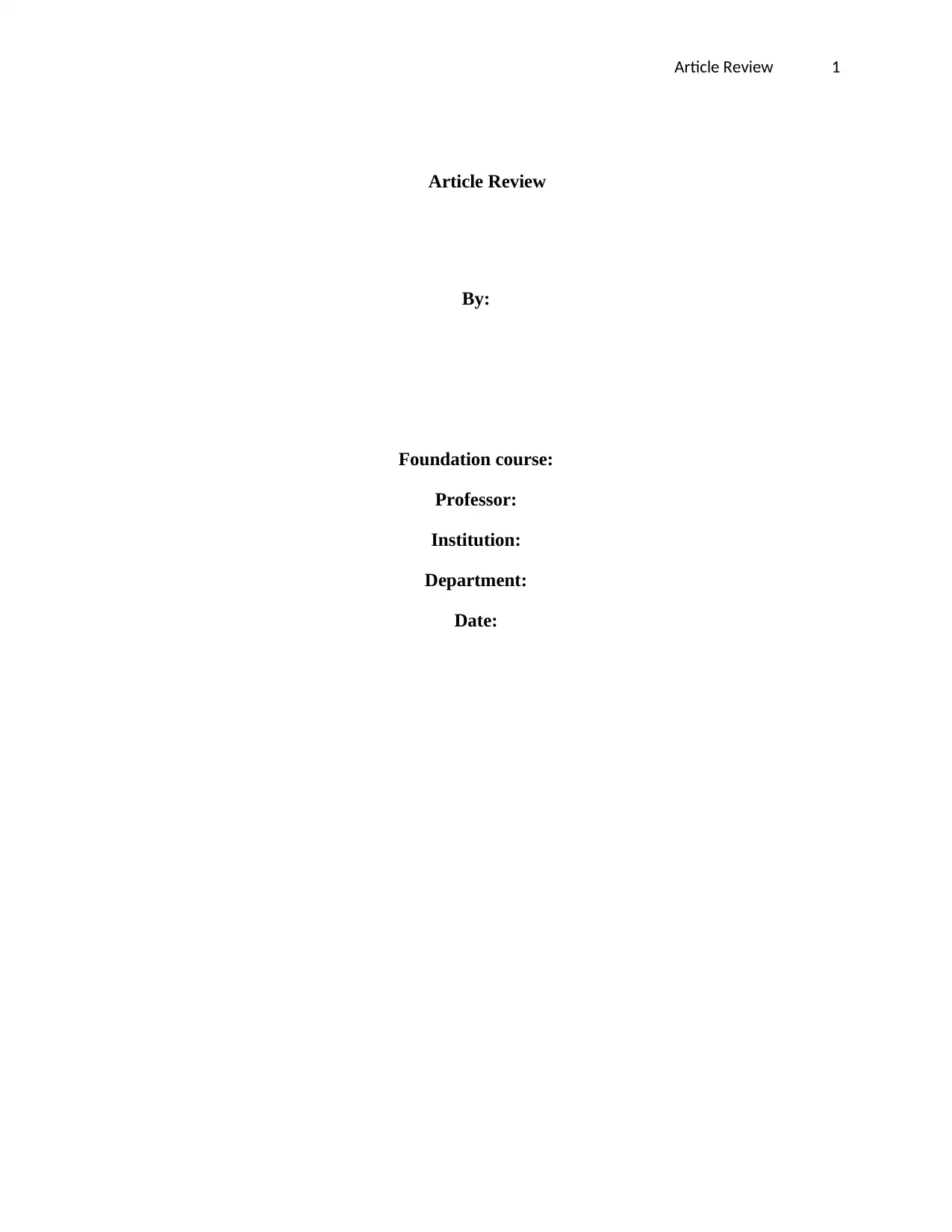
Article Review 1
Article Review
By:
Foundation course:
Professor:
Institution:
Department:
Date:
Article Review
By:
Foundation course:
Professor:
Institution:
Department:
Date:
Secure Best Marks with AI Grader
Need help grading? Try our AI Grader for instant feedback on your assignments.
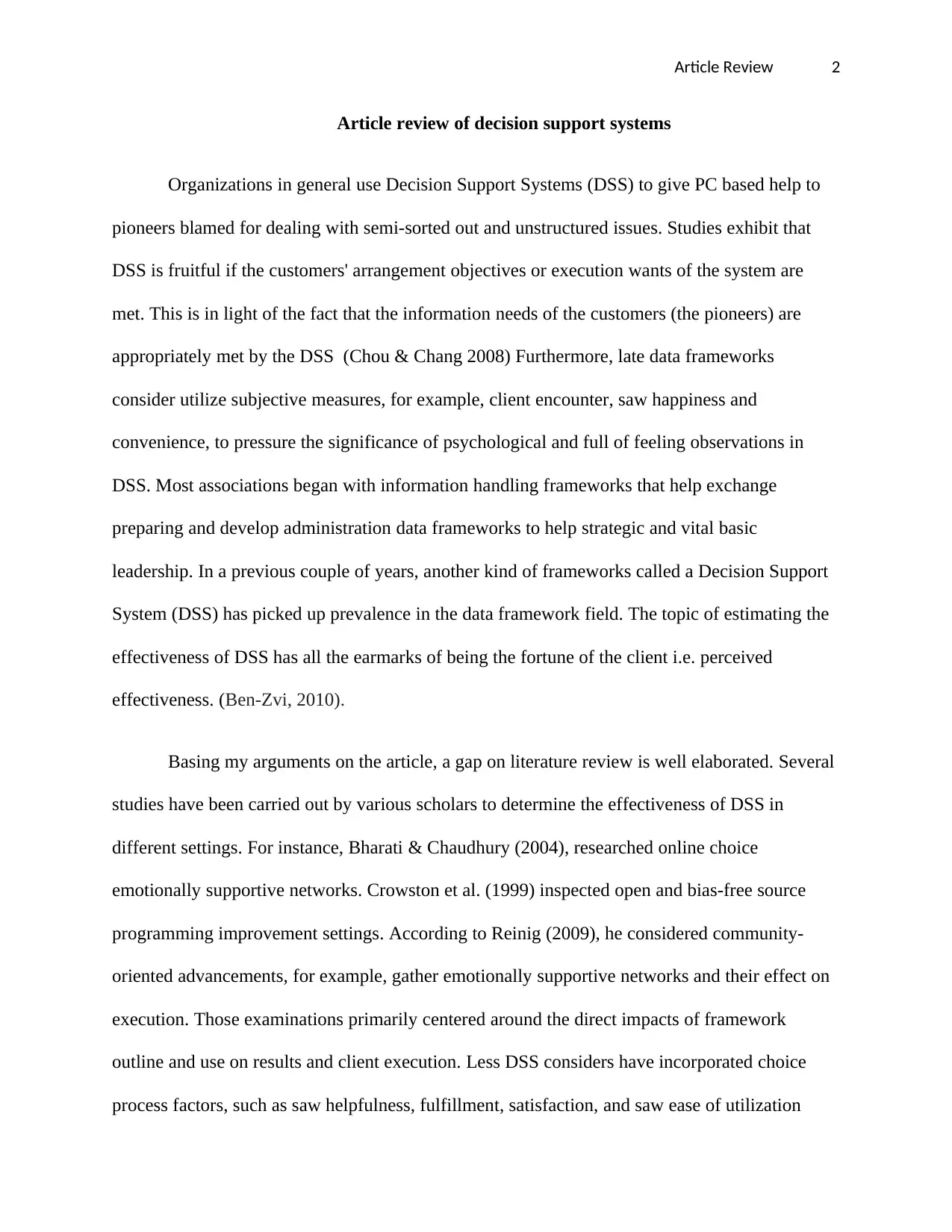
Article Review 2
Article review of decision support systems
Organizations in general use Decision Support Systems (DSS) to give PC based help to
pioneers blamed for dealing with semi-sorted out and unstructured issues. Studies exhibit that
DSS is fruitful if the customers' arrangement objectives or execution wants of the system are
met. This is in light of the fact that the information needs of the customers (the pioneers) are
appropriately met by the DSS (Chou & Chang 2008) Furthermore, late data frameworks
consider utilize subjective measures, for example, client encounter, saw happiness and
convenience, to pressure the significance of psychological and full of feeling observations in
DSS. Most associations began with information handling frameworks that help exchange
preparing and develop administration data frameworks to help strategic and vital basic
leadership. In a previous couple of years, another kind of frameworks called a Decision Support
System (DSS) has picked up prevalence in the data framework field. The topic of estimating the
effectiveness of DSS has all the earmarks of being the fortune of the client i.e. perceived
effectiveness. (Ben-Zvi, 2010).
Basing my arguments on the article, a gap on literature review is well elaborated. Several
studies have been carried out by various scholars to determine the effectiveness of DSS in
different settings. For instance, Bharati & Chaudhury (2004), researched online choice
emotionally supportive networks. Crowston et al. (1999) inspected open and bias-free source
programming improvement settings. According to Reinig (2009), he considered community-
oriented advancements, for example, gather emotionally supportive networks and their effect on
execution. Those examinations primarily centered around the direct impacts of framework
outline and use on results and client execution. Less DSS considers have incorporated choice
process factors, such as saw helpfulness, fulfillment, satisfaction, and saw ease of utilization
Article review of decision support systems
Organizations in general use Decision Support Systems (DSS) to give PC based help to
pioneers blamed for dealing with semi-sorted out and unstructured issues. Studies exhibit that
DSS is fruitful if the customers' arrangement objectives or execution wants of the system are
met. This is in light of the fact that the information needs of the customers (the pioneers) are
appropriately met by the DSS (Chou & Chang 2008) Furthermore, late data frameworks
consider utilize subjective measures, for example, client encounter, saw happiness and
convenience, to pressure the significance of psychological and full of feeling observations in
DSS. Most associations began with information handling frameworks that help exchange
preparing and develop administration data frameworks to help strategic and vital basic
leadership. In a previous couple of years, another kind of frameworks called a Decision Support
System (DSS) has picked up prevalence in the data framework field. The topic of estimating the
effectiveness of DSS has all the earmarks of being the fortune of the client i.e. perceived
effectiveness. (Ben-Zvi, 2010).
Basing my arguments on the article, a gap on literature review is well elaborated. Several
studies have been carried out by various scholars to determine the effectiveness of DSS in
different settings. For instance, Bharati & Chaudhury (2004), researched online choice
emotionally supportive networks. Crowston et al. (1999) inspected open and bias-free source
programming improvement settings. According to Reinig (2009), he considered community-
oriented advancements, for example, gather emotionally supportive networks and their effect on
execution. Those examinations primarily centered around the direct impacts of framework
outline and use on results and client execution. Less DSS considers have incorporated choice
process factors, such as saw helpfulness, fulfillment, satisfaction, and saw ease of utilization
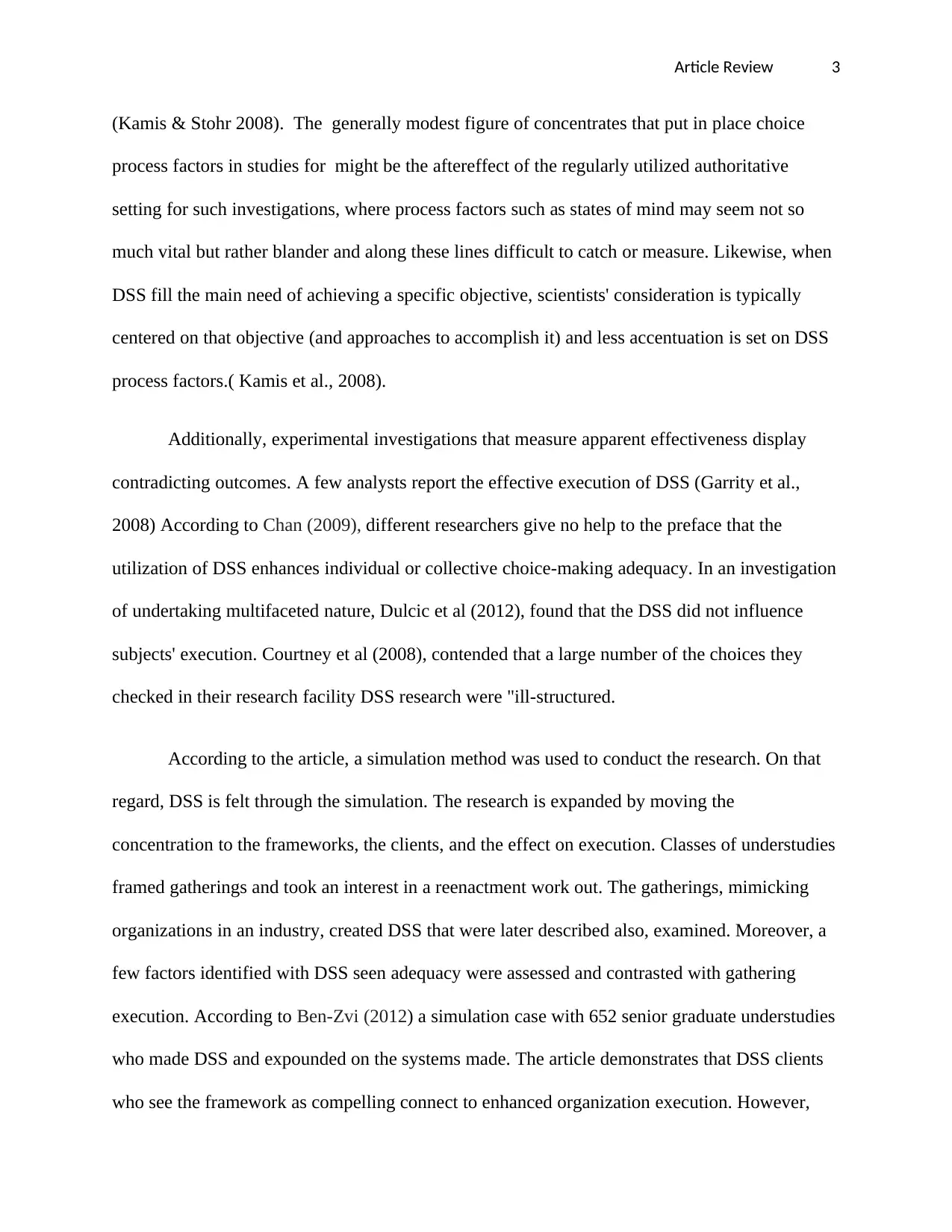
Article Review 3
(Kamis & Stohr 2008). The generally modest figure of concentrates that put in place choice
process factors in studies for might be the aftereffect of the regularly utilized authoritative
setting for such investigations, where process factors such as states of mind may seem not so
much vital but rather blander and along these lines difficult to catch or measure. Likewise, when
DSS fill the main need of achieving a specific objective, scientists' consideration is typically
centered on that objective (and approaches to accomplish it) and less accentuation is set on DSS
process factors.( Kamis et al., 2008).
Additionally, experimental investigations that measure apparent effectiveness display
contradicting outcomes. A few analysts report the effective execution of DSS (Garrity et al.,
2008) According to Chan (2009), different researchers give no help to the preface that the
utilization of DSS enhances individual or collective choice-making adequacy. In an investigation
of undertaking multifaceted nature, Dulcic et al (2012), found that the DSS did not influence
subjects' execution. Courtney et al (2008), contended that a large number of the choices they
checked in their research facility DSS research were "ill-structured.
According to the article, a simulation method was used to conduct the research. On that
regard, DSS is felt through the simulation. The research is expanded by moving the
concentration to the frameworks, the clients, and the effect on execution. Classes of understudies
framed gatherings and took an interest in a reenactment work out. The gatherings, mimicking
organizations in an industry, created DSS that were later described also, examined. Moreover, a
few factors identified with DSS seen adequacy were assessed and contrasted with gathering
execution. According to Ben-Zvi (2012) a simulation case with 652 senior graduate understudies
who made DSS and expounded on the systems made. The article demonstrates that DSS clients
who see the framework as compelling connect to enhanced organization execution. However,
(Kamis & Stohr 2008). The generally modest figure of concentrates that put in place choice
process factors in studies for might be the aftereffect of the regularly utilized authoritative
setting for such investigations, where process factors such as states of mind may seem not so
much vital but rather blander and along these lines difficult to catch or measure. Likewise, when
DSS fill the main need of achieving a specific objective, scientists' consideration is typically
centered on that objective (and approaches to accomplish it) and less accentuation is set on DSS
process factors.( Kamis et al., 2008).
Additionally, experimental investigations that measure apparent effectiveness display
contradicting outcomes. A few analysts report the effective execution of DSS (Garrity et al.,
2008) According to Chan (2009), different researchers give no help to the preface that the
utilization of DSS enhances individual or collective choice-making adequacy. In an investigation
of undertaking multifaceted nature, Dulcic et al (2012), found that the DSS did not influence
subjects' execution. Courtney et al (2008), contended that a large number of the choices they
checked in their research facility DSS research were "ill-structured.
According to the article, a simulation method was used to conduct the research. On that
regard, DSS is felt through the simulation. The research is expanded by moving the
concentration to the frameworks, the clients, and the effect on execution. Classes of understudies
framed gatherings and took an interest in a reenactment work out. The gatherings, mimicking
organizations in an industry, created DSS that were later described also, examined. Moreover, a
few factors identified with DSS seen adequacy were assessed and contrasted with gathering
execution. According to Ben-Zvi (2012) a simulation case with 652 senior graduate understudies
who made DSS and expounded on the systems made. The article demonstrates that DSS clients
who see the framework as compelling connect to enhanced organization execution. However,
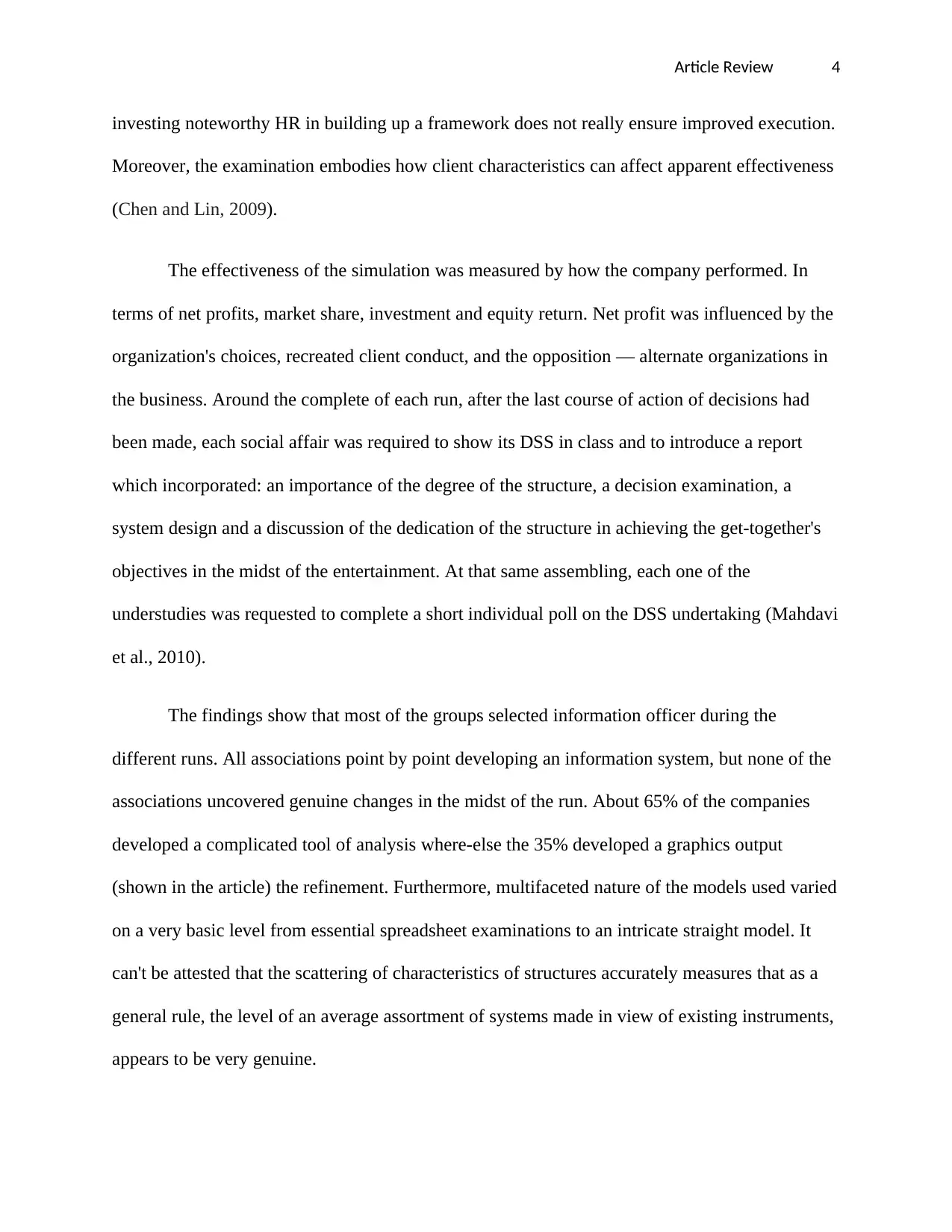
Article Review 4
investing noteworthy HR in building up a framework does not really ensure improved execution.
Moreover, the examination embodies how client characteristics can affect apparent effectiveness
(Chen and Lin, 2009).
The effectiveness of the simulation was measured by how the company performed. In
terms of net profits, market share, investment and equity return. Net profit was influenced by the
organization's choices, recreated client conduct, and the opposition — alternate organizations in
the business. Around the complete of each run, after the last course of action of decisions had
been made, each social affair was required to show its DSS in class and to introduce a report
which incorporated: an importance of the degree of the structure, a decision examination, a
system design and a discussion of the dedication of the structure in achieving the get-together's
objectives in the midst of the entertainment. At that same assembling, each one of the
understudies was requested to complete a short individual poll on the DSS undertaking (Mahdavi
et al., 2010).
The findings show that most of the groups selected information officer during the
different runs. All associations point by point developing an information system, but none of the
associations uncovered genuine changes in the midst of the run. About 65% of the companies
developed a complicated tool of analysis where-else the 35% developed a graphics output
(shown in the article) the refinement. Furthermore, multifaceted nature of the models used varied
on a very basic level from essential spreadsheet examinations to an intricate straight model. It
can't be attested that the scattering of characteristics of structures accurately measures that as a
general rule, the level of an average assortment of systems made in view of existing instruments,
appears to be very genuine.
investing noteworthy HR in building up a framework does not really ensure improved execution.
Moreover, the examination embodies how client characteristics can affect apparent effectiveness
(Chen and Lin, 2009).
The effectiveness of the simulation was measured by how the company performed. In
terms of net profits, market share, investment and equity return. Net profit was influenced by the
organization's choices, recreated client conduct, and the opposition — alternate organizations in
the business. Around the complete of each run, after the last course of action of decisions had
been made, each social affair was required to show its DSS in class and to introduce a report
which incorporated: an importance of the degree of the structure, a decision examination, a
system design and a discussion of the dedication of the structure in achieving the get-together's
objectives in the midst of the entertainment. At that same assembling, each one of the
understudies was requested to complete a short individual poll on the DSS undertaking (Mahdavi
et al., 2010).
The findings show that most of the groups selected information officer during the
different runs. All associations point by point developing an information system, but none of the
associations uncovered genuine changes in the midst of the run. About 65% of the companies
developed a complicated tool of analysis where-else the 35% developed a graphics output
(shown in the article) the refinement. Furthermore, multifaceted nature of the models used varied
on a very basic level from essential spreadsheet examinations to an intricate straight model. It
can't be attested that the scattering of characteristics of structures accurately measures that as a
general rule, the level of an average assortment of systems made in view of existing instruments,
appears to be very genuine.
Secure Best Marks with AI Grader
Need help grading? Try our AI Grader for instant feedback on your assignments.
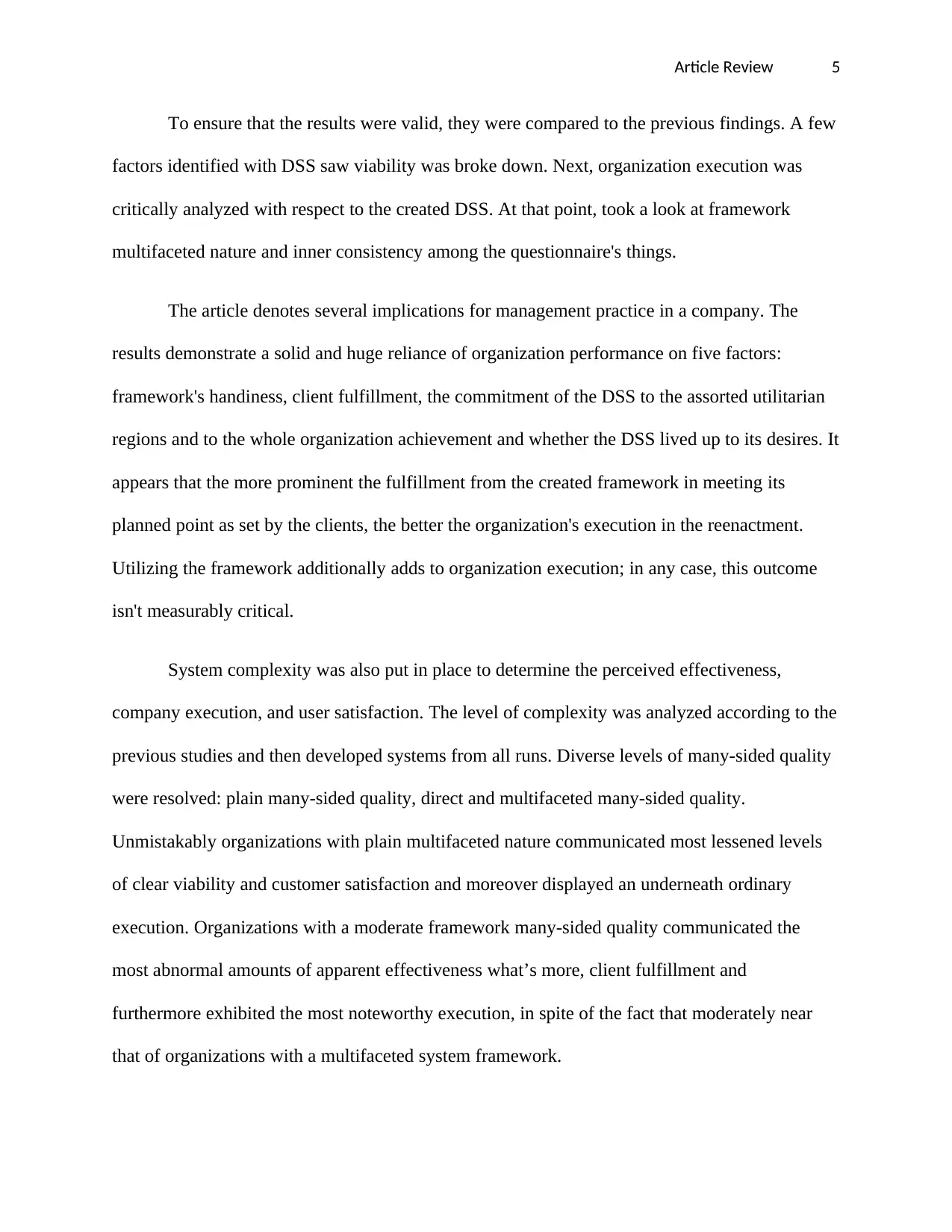
Article Review 5
To ensure that the results were valid, they were compared to the previous findings. A few
factors identified with DSS saw viability was broke down. Next, organization execution was
critically analyzed with respect to the created DSS. At that point, took a look at framework
multifaceted nature and inner consistency among the questionnaire's things.
The article denotes several implications for management practice in a company. The
results demonstrate a solid and huge reliance of organization performance on five factors:
framework's handiness, client fulfillment, the commitment of the DSS to the assorted utilitarian
regions and to the whole organization achievement and whether the DSS lived up to its desires. It
appears that the more prominent the fulfillment from the created framework in meeting its
planned point as set by the clients, the better the organization's execution in the reenactment.
Utilizing the framework additionally adds to organization execution; in any case, this outcome
isn't measurably critical.
System complexity was also put in place to determine the perceived effectiveness,
company execution, and user satisfaction. The level of complexity was analyzed according to the
previous studies and then developed systems from all runs. Diverse levels of many-sided quality
were resolved: plain many-sided quality, direct and multifaceted many-sided quality.
Unmistakably organizations with plain multifaceted nature communicated most lessened levels
of clear viability and customer satisfaction and moreover displayed an underneath ordinary
execution. Organizations with a moderate framework many-sided quality communicated the
most abnormal amounts of apparent effectiveness what’s more, client fulfillment and
furthermore exhibited the most noteworthy execution, in spite of the fact that moderately near
that of organizations with a multifaceted system framework.
To ensure that the results were valid, they were compared to the previous findings. A few
factors identified with DSS saw viability was broke down. Next, organization execution was
critically analyzed with respect to the created DSS. At that point, took a look at framework
multifaceted nature and inner consistency among the questionnaire's things.
The article denotes several implications for management practice in a company. The
results demonstrate a solid and huge reliance of organization performance on five factors:
framework's handiness, client fulfillment, the commitment of the DSS to the assorted utilitarian
regions and to the whole organization achievement and whether the DSS lived up to its desires. It
appears that the more prominent the fulfillment from the created framework in meeting its
planned point as set by the clients, the better the organization's execution in the reenactment.
Utilizing the framework additionally adds to organization execution; in any case, this outcome
isn't measurably critical.
System complexity was also put in place to determine the perceived effectiveness,
company execution, and user satisfaction. The level of complexity was analyzed according to the
previous studies and then developed systems from all runs. Diverse levels of many-sided quality
were resolved: plain many-sided quality, direct and multifaceted many-sided quality.
Unmistakably organizations with plain multifaceted nature communicated most lessened levels
of clear viability and customer satisfaction and moreover displayed an underneath ordinary
execution. Organizations with a moderate framework many-sided quality communicated the
most abnormal amounts of apparent effectiveness what’s more, client fulfillment and
furthermore exhibited the most noteworthy execution, in spite of the fact that moderately near
that of organizations with a multifaceted system framework.
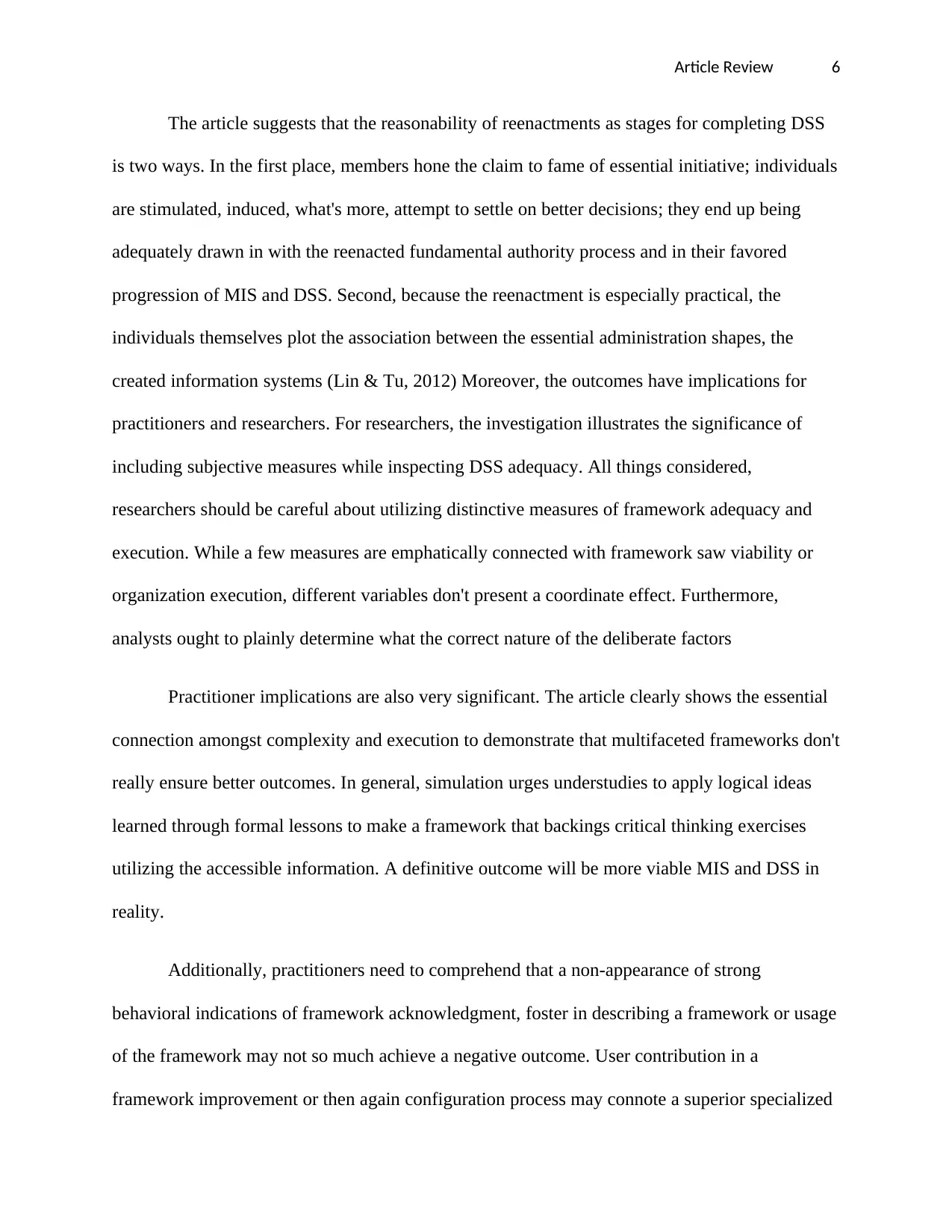
Article Review 6
The article suggests that the reasonability of reenactments as stages for completing DSS
is two ways. In the first place, members hone the claim to fame of essential initiative; individuals
are stimulated, induced, what's more, attempt to settle on better decisions; they end up being
adequately drawn in with the reenacted fundamental authority process and in their favored
progression of MIS and DSS. Second, because the reenactment is especially practical, the
individuals themselves plot the association between the essential administration shapes, the
created information systems (Lin & Tu, 2012) Moreover, the outcomes have implications for
practitioners and researchers. For researchers, the investigation illustrates the significance of
including subjective measures while inspecting DSS adequacy. All things considered,
researchers should be careful about utilizing distinctive measures of framework adequacy and
execution. While a few measures are emphatically connected with framework saw viability or
organization execution, different variables don't present a coordinate effect. Furthermore,
analysts ought to plainly determine what the correct nature of the deliberate factors
Practitioner implications are also very significant. The article clearly shows the essential
connection amongst complexity and execution to demonstrate that multifaceted frameworks don't
really ensure better outcomes. In general, simulation urges understudies to apply logical ideas
learned through formal lessons to make a framework that backings critical thinking exercises
utilizing the accessible information. A definitive outcome will be more viable MIS and DSS in
reality.
Additionally, practitioners need to comprehend that a non-appearance of strong
behavioral indications of framework acknowledgment, foster in describing a framework or usage
of the framework may not so much achieve a negative outcome. User contribution in a
framework improvement or then again configuration process may connote a superior specialized
The article suggests that the reasonability of reenactments as stages for completing DSS
is two ways. In the first place, members hone the claim to fame of essential initiative; individuals
are stimulated, induced, what's more, attempt to settle on better decisions; they end up being
adequately drawn in with the reenacted fundamental authority process and in their favored
progression of MIS and DSS. Second, because the reenactment is especially practical, the
individuals themselves plot the association between the essential administration shapes, the
created information systems (Lin & Tu, 2012) Moreover, the outcomes have implications for
practitioners and researchers. For researchers, the investigation illustrates the significance of
including subjective measures while inspecting DSS adequacy. All things considered,
researchers should be careful about utilizing distinctive measures of framework adequacy and
execution. While a few measures are emphatically connected with framework saw viability or
organization execution, different variables don't present a coordinate effect. Furthermore,
analysts ought to plainly determine what the correct nature of the deliberate factors
Practitioner implications are also very significant. The article clearly shows the essential
connection amongst complexity and execution to demonstrate that multifaceted frameworks don't
really ensure better outcomes. In general, simulation urges understudies to apply logical ideas
learned through formal lessons to make a framework that backings critical thinking exercises
utilizing the accessible information. A definitive outcome will be more viable MIS and DSS in
reality.
Additionally, practitioners need to comprehend that a non-appearance of strong
behavioral indications of framework acknowledgment, foster in describing a framework or usage
of the framework may not so much achieve a negative outcome. User contribution in a
framework improvement or then again configuration process may connote a superior specialized
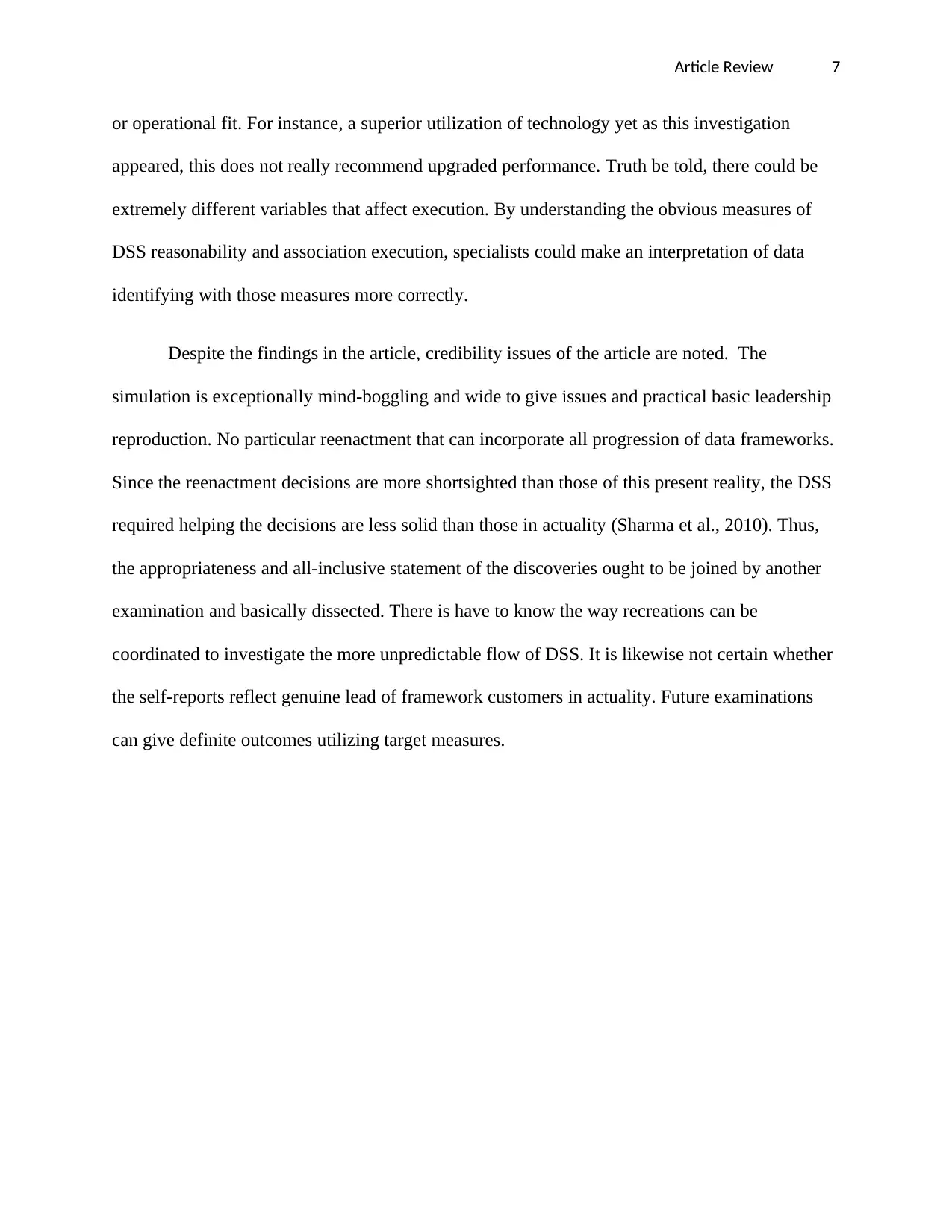
Article Review 7
or operational fit. For instance, a superior utilization of technology yet as this investigation
appeared, this does not really recommend upgraded performance. Truth be told, there could be
extremely different variables that affect execution. By understanding the obvious measures of
DSS reasonability and association execution, specialists could make an interpretation of data
identifying with those measures more correctly.
Despite the findings in the article, credibility issues of the article are noted. The
simulation is exceptionally mind-boggling and wide to give issues and practical basic leadership
reproduction. No particular reenactment that can incorporate all progression of data frameworks.
Since the reenactment decisions are more shortsighted than those of this present reality, the DSS
required helping the decisions are less solid than those in actuality (Sharma et al., 2010). Thus,
the appropriateness and all-inclusive statement of the discoveries ought to be joined by another
examination and basically dissected. There is have to know the way recreations can be
coordinated to investigate the more unpredictable flow of DSS. It is likewise not certain whether
the self-reports reflect genuine lead of framework customers in actuality. Future examinations
can give definite outcomes utilizing target measures.
or operational fit. For instance, a superior utilization of technology yet as this investigation
appeared, this does not really recommend upgraded performance. Truth be told, there could be
extremely different variables that affect execution. By understanding the obvious measures of
DSS reasonability and association execution, specialists could make an interpretation of data
identifying with those measures more correctly.
Despite the findings in the article, credibility issues of the article are noted. The
simulation is exceptionally mind-boggling and wide to give issues and practical basic leadership
reproduction. No particular reenactment that can incorporate all progression of data frameworks.
Since the reenactment decisions are more shortsighted than those of this present reality, the DSS
required helping the decisions are less solid than those in actuality (Sharma et al., 2010). Thus,
the appropriateness and all-inclusive statement of the discoveries ought to be joined by another
examination and basically dissected. There is have to know the way recreations can be
coordinated to investigate the more unpredictable flow of DSS. It is likewise not certain whether
the self-reports reflect genuine lead of framework customers in actuality. Future examinations
can give definite outcomes utilizing target measures.
Paraphrase This Document
Need a fresh take? Get an instant paraphrase of this document with our AI Paraphraser
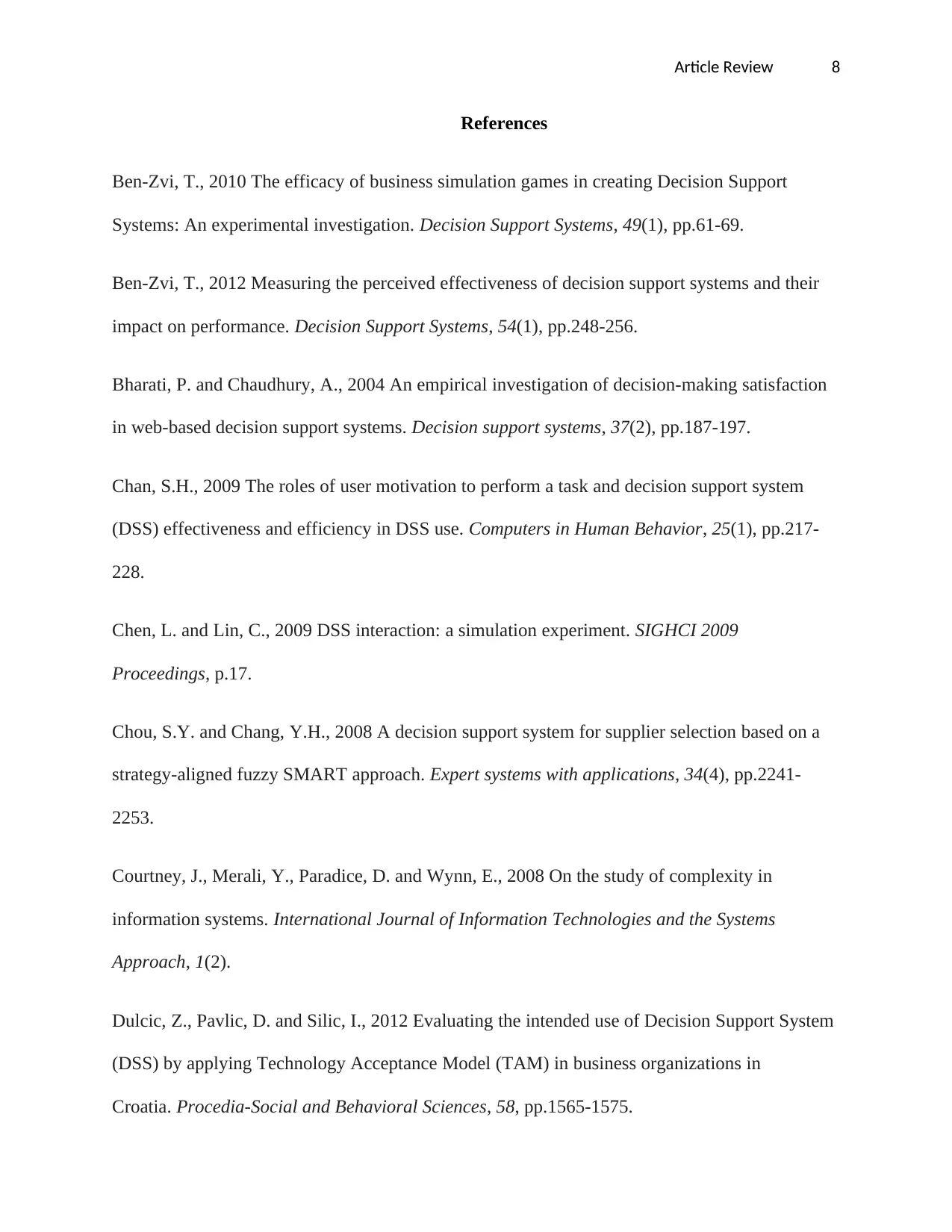
Article Review 8
References
Ben-Zvi, T., 2010 The efficacy of business simulation games in creating Decision Support
Systems: An experimental investigation. Decision Support Systems, 49(1), pp.61-69.
Ben-Zvi, T., 2012 Measuring the perceived effectiveness of decision support systems and their
impact on performance. Decision Support Systems, 54(1), pp.248-256.
Bharati, P. and Chaudhury, A., 2004 An empirical investigation of decision-making satisfaction
in web-based decision support systems. Decision support systems, 37(2), pp.187-197.
Chan, S.H., 2009 The roles of user motivation to perform a task and decision support system
(DSS) effectiveness and efficiency in DSS use. Computers in Human Behavior, 25(1), pp.217-
228.
Chen, L. and Lin, C., 2009 DSS interaction: a simulation experiment. SIGHCI 2009
Proceedings, p.17.
Chou, S.Y. and Chang, Y.H., 2008 A decision support system for supplier selection based on a
strategy-aligned fuzzy SMART approach. Expert systems with applications, 34(4), pp.2241-
2253.
Courtney, J., Merali, Y., Paradice, D. and Wynn, E., 2008 On the study of complexity in
information systems. International Journal of Information Technologies and the Systems
Approach, 1(2).
Dulcic, Z., Pavlic, D. and Silic, I., 2012 Evaluating the intended use of Decision Support System
(DSS) by applying Technology Acceptance Model (TAM) in business organizations in
Croatia. Procedia-Social and Behavioral Sciences, 58, pp.1565-1575.
References
Ben-Zvi, T., 2010 The efficacy of business simulation games in creating Decision Support
Systems: An experimental investigation. Decision Support Systems, 49(1), pp.61-69.
Ben-Zvi, T., 2012 Measuring the perceived effectiveness of decision support systems and their
impact on performance. Decision Support Systems, 54(1), pp.248-256.
Bharati, P. and Chaudhury, A., 2004 An empirical investigation of decision-making satisfaction
in web-based decision support systems. Decision support systems, 37(2), pp.187-197.
Chan, S.H., 2009 The roles of user motivation to perform a task and decision support system
(DSS) effectiveness and efficiency in DSS use. Computers in Human Behavior, 25(1), pp.217-
228.
Chen, L. and Lin, C., 2009 DSS interaction: a simulation experiment. SIGHCI 2009
Proceedings, p.17.
Chou, S.Y. and Chang, Y.H., 2008 A decision support system for supplier selection based on a
strategy-aligned fuzzy SMART approach. Expert systems with applications, 34(4), pp.2241-
2253.
Courtney, J., Merali, Y., Paradice, D. and Wynn, E., 2008 On the study of complexity in
information systems. International Journal of Information Technologies and the Systems
Approach, 1(2).
Dulcic, Z., Pavlic, D. and Silic, I., 2012 Evaluating the intended use of Decision Support System
(DSS) by applying Technology Acceptance Model (TAM) in business organizations in
Croatia. Procedia-Social and Behavioral Sciences, 58, pp.1565-1575.
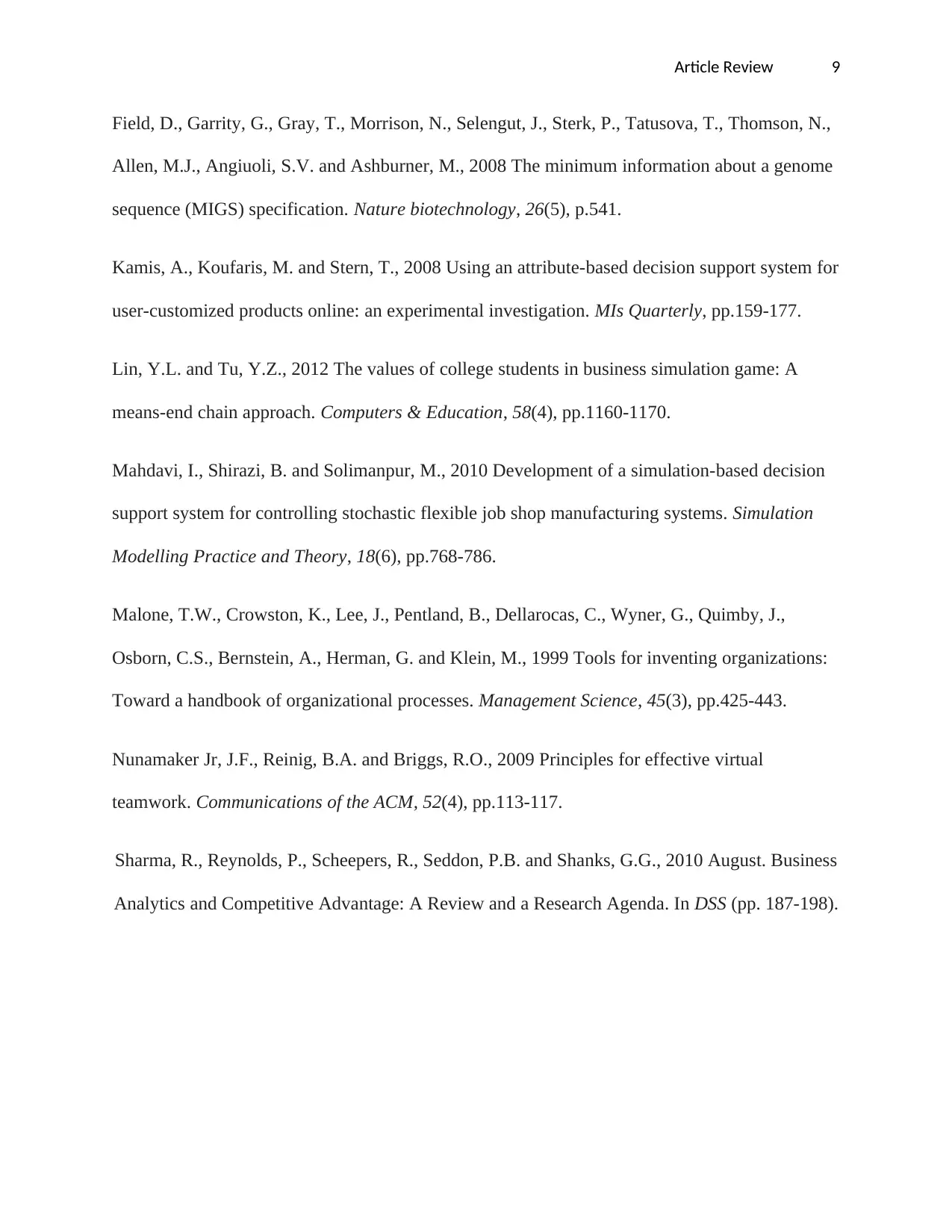
Article Review 9
Field, D., Garrity, G., Gray, T., Morrison, N., Selengut, J., Sterk, P., Tatusova, T., Thomson, N.,
Allen, M.J., Angiuoli, S.V. and Ashburner, M., 2008 The minimum information about a genome
sequence (MIGS) specification. Nature biotechnology, 26(5), p.541.
Kamis, A., Koufaris, M. and Stern, T., 2008 Using an attribute-based decision support system for
user-customized products online: an experimental investigation. MIs Quarterly, pp.159-177.
Lin, Y.L. and Tu, Y.Z., 2012 The values of college students in business simulation game: A
means-end chain approach. Computers & Education, 58(4), pp.1160-1170.
Mahdavi, I., Shirazi, B. and Solimanpur, M., 2010 Development of a simulation-based decision
support system for controlling stochastic flexible job shop manufacturing systems. Simulation
Modelling Practice and Theory, 18(6), pp.768-786.
Malone, T.W., Crowston, K., Lee, J., Pentland, B., Dellarocas, C., Wyner, G., Quimby, J.,
Osborn, C.S., Bernstein, A., Herman, G. and Klein, M., 1999 Tools for inventing organizations:
Toward a handbook of organizational processes. Management Science, 45(3), pp.425-443.
Nunamaker Jr, J.F., Reinig, B.A. and Briggs, R.O., 2009 Principles for effective virtual
teamwork. Communications of the ACM, 52(4), pp.113-117.
Sharma, R., Reynolds, P., Scheepers, R., Seddon, P.B. and Shanks, G.G., 2010 August. Business
Analytics and Competitive Advantage: A Review and a Research Agenda. In DSS (pp. 187-198).
Field, D., Garrity, G., Gray, T., Morrison, N., Selengut, J., Sterk, P., Tatusova, T., Thomson, N.,
Allen, M.J., Angiuoli, S.V. and Ashburner, M., 2008 The minimum information about a genome
sequence (MIGS) specification. Nature biotechnology, 26(5), p.541.
Kamis, A., Koufaris, M. and Stern, T., 2008 Using an attribute-based decision support system for
user-customized products online: an experimental investigation. MIs Quarterly, pp.159-177.
Lin, Y.L. and Tu, Y.Z., 2012 The values of college students in business simulation game: A
means-end chain approach. Computers & Education, 58(4), pp.1160-1170.
Mahdavi, I., Shirazi, B. and Solimanpur, M., 2010 Development of a simulation-based decision
support system for controlling stochastic flexible job shop manufacturing systems. Simulation
Modelling Practice and Theory, 18(6), pp.768-786.
Malone, T.W., Crowston, K., Lee, J., Pentland, B., Dellarocas, C., Wyner, G., Quimby, J.,
Osborn, C.S., Bernstein, A., Herman, G. and Klein, M., 1999 Tools for inventing organizations:
Toward a handbook of organizational processes. Management Science, 45(3), pp.425-443.
Nunamaker Jr, J.F., Reinig, B.A. and Briggs, R.O., 2009 Principles for effective virtual
teamwork. Communications of the ACM, 52(4), pp.113-117.
Sharma, R., Reynolds, P., Scheepers, R., Seddon, P.B. and Shanks, G.G., 2010 August. Business
Analytics and Competitive Advantage: A Review and a Research Agenda. In DSS (pp. 187-198).
1 out of 9
Related Documents
Your All-in-One AI-Powered Toolkit for Academic Success.
+13062052269
info@desklib.com
Available 24*7 on WhatsApp / Email
![[object Object]](/_next/static/media/star-bottom.7253800d.svg)
Unlock your academic potential
© 2024 | Zucol Services PVT LTD | All rights reserved.





